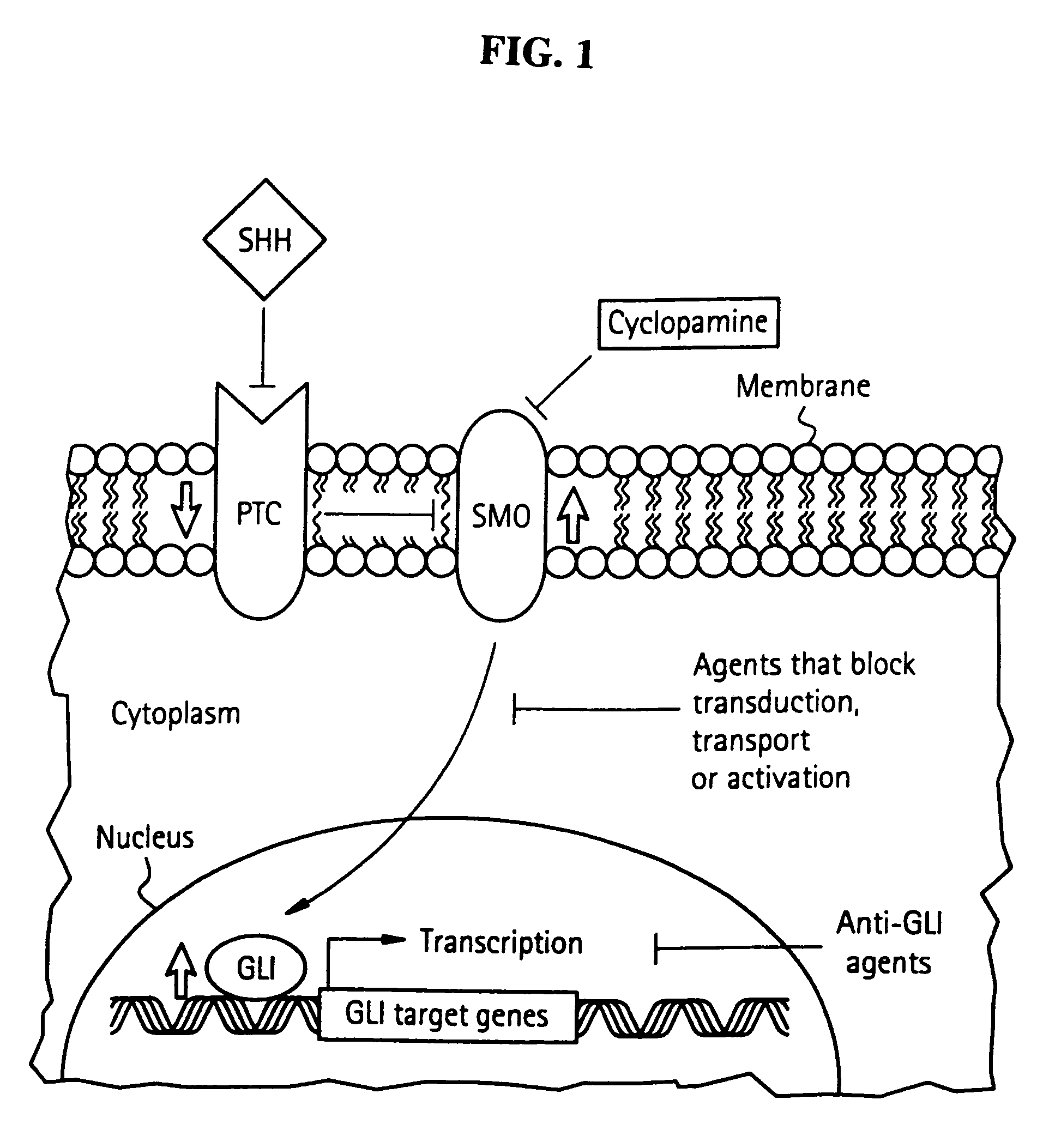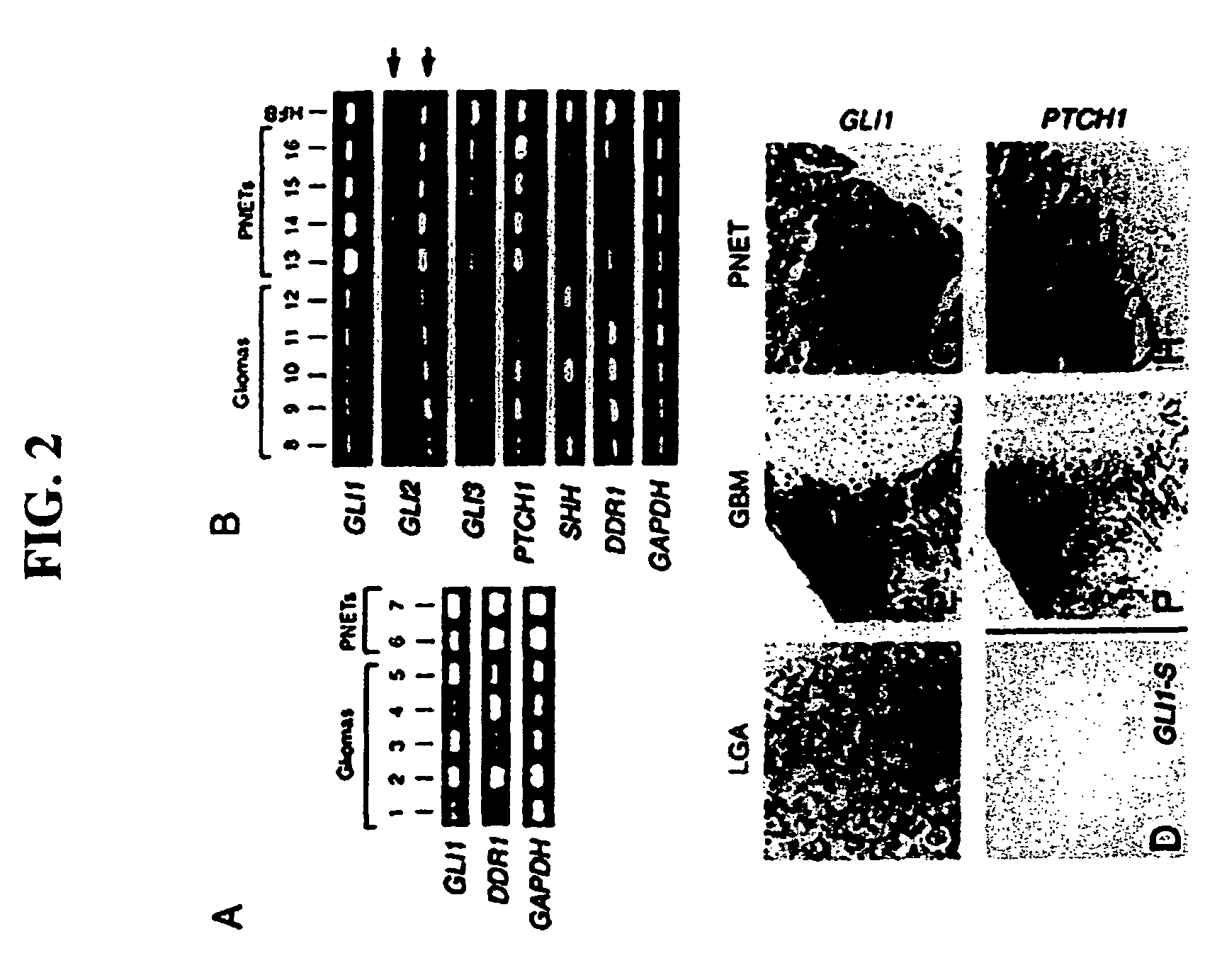Method and compositions for inhibiting tumorigenesis
a tumorigenesis and composition technology, applied in the field of pathology diagnosis and treatment, can solve the problems of poor prognosis of lung cancer patients, poor survival rate of patients with lung cancer, and development of basal-cell carcinoma-like and other skin tumors, and achieve the effects of preventing or inhibiting apoptosis, preventing the tumorigenic effect of the shh/gli pathway, and effective
- Summary
- Abstract
- Description
- Claims
- Application Information
AI Technical Summary
Benefits of technology
Problems solved by technology
Method used
Image
Examples
specific embodiments
[0304]As shown below the inventors have not only examined the role of GLI proteins in carcinogenesis, in particular lung, but have explored the effects of Gli1 on apoptosis induced by various chemotherapeutic agents. The inventors have provided evidence to support a role for GLI in tumorigenesis and more importantly from a clinical point of view, in resistance to cell killing by cancer chemotherapeutic agents.
example 1
SHH-GLI Signaling and Tumorigenesis
Animals
[0306]Swiss-Webster mice were used unless otherwise specified. The Shh (Chiang et al., (1996) Nature 383, 407-413), Gli1 (Park et al., (2000) Development 127, 1593-1605) and Gli2 (Mo et al., (1997) Development 124, 113-123.) mutants from our colony were in this background. Cortical explants were prepared as previously described (Dahmane et al., (2001) Development 128, 5201-5212) and treated for 48 h. Anti-SHH antibodies were used at 4 μg / ml (University of Iowa Hybridoma Bank). Octyl-modified SHH-N protein was a kind gift from Ontogeny / Curis Inc. Human tumor samples were derived from the operating room or from the NYU tumor banks. Brain tumor cell lines were obtained from ATCC and grown according to its specifications. GL261 was a kind gift of Dr D. Zagzag. Frog (Xenopus laevis) embryos were obtained, reared and staged by standard methods. Tadpoles were ˜2 days old. All statistical analyses were carried out using the Student's t test and devi...
example 2
Prevalent Expression of GLI1 in Lung Cancer and Increased Resistance to Apoptosis
[0338]The inventors have examined the role of GLI1 in lung carcinogenesis and apoptosis. As shown below, the inventors provide evidence to support a role for GLI1 in lung tumorigenesis and more importantly from a clinical point of view, in resistance to cell killing by cancer chemotherapeutic agents.
Materials and Methods
Chemicals and Reagents
[0339]Staurosporine and etoposide were obtained from Sigma Chemical Co. (Saint Louis, Mo.) or ALEXIS Co. (San Diego, Calif.) and dissolved in DMSO (Sigma). All cell culture supplies were from Mediatech, Inc. (Herndon, Va.).
Tissue Specimens and Cell Culture
[0340]Matched primary lung cancer and normal lung tissues were obtained after approved by New York University School of Medicine Human Subjects Institutional Review Board. After surgery, tumor samples and the corresponding normal lung tissues were snap-frozen in liquid N2, and stored at −80° C. Table 1 summarizes t...
PUM
| Property | Measurement | Unit |
|---|---|---|
| molecular weight | aaaaa | aaaaa |
| molecular weight | aaaaa | aaaaa |
| pH | aaaaa | aaaaa |
Abstract
Description
Claims
Application Information
 Login to View More
Login to View More - R&D
- Intellectual Property
- Life Sciences
- Materials
- Tech Scout
- Unparalleled Data Quality
- Higher Quality Content
- 60% Fewer Hallucinations
Browse by: Latest US Patents, China's latest patents, Technical Efficacy Thesaurus, Application Domain, Technology Topic, Popular Technical Reports.
© 2025 PatSnap. All rights reserved.Legal|Privacy policy|Modern Slavery Act Transparency Statement|Sitemap|About US| Contact US: help@patsnap.com



